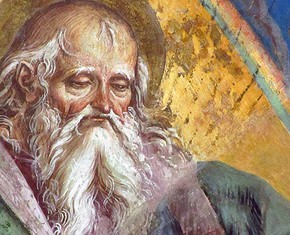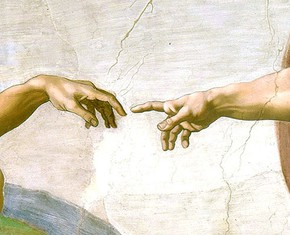The views expressed in our content reflect individual perspectives and do not represent the authoritative views of the Baha'i Faith.
In the Baha’i writings, Baha’u’llah uses beautifully figurative, metaphorical and symbolic language—as well as interpreting prefigurative, prophetic scripture from the Bible, the Qur’an, and other sacred texts.
To see all of those at work, we’ll look at Baha’u’llah’s interpretation of a Christian prophecy from Matthew 24:29–31.
Scholars call the entire chapter of Matthew 24 (and its parallel, Mark, Chapter 13) the “Minor Apocalypse.” Let’s see how Baha’u’llah begins to interpret this verse:
These are the melodies, sung by Jesus, Son of Mary, in accents of majestic power in the Riḍván [Paradise] of the Gospel, revealing those signs that must needs herald the advent of the Manifestation after Him. In the first Gospel according to Matthew it is recorded: And when they asked Jesus concerning the signs of His coming, He said unto them: “Immediately after the oppression of those days shall the sun be darkened, and the moon shall not give her light, and the stars shall fall from heaven, and the powers of the earth shall be shaken: and then shall appear the sign of the Son of man in heaven: and then shall all the tribes of the earth mourn, and they shall see the Son of man coming in the clouds of heaven with power and great glory. And he shall send his angels with a great sound of a trumpet.” [Matthew 24:29–31.] –Baha’u’llah, The Book of Certitude, pp. 24-25.
Here, the text differs slightly from the King James Version, probably because it is being read from the translation of the New Testament into Arabic. Now let’s see if the “Four Steps to Figuring Out Prophecy” can help us better understand and appreciate in the dynamics of Baha’u’llah’s interpretation of Matthew 24:29–31.
Step 1: If impossible, then not literal.
Why is the literal reading not possible here?
(Appeal to absurdity.)
Baha’u’llah states that “the Christian divines have failed to apprehend the meaning of these words, and did not recognize their object and purpose” by having “clung to the literal interpretation of the words of Jesus” (The Book of Certitude, p. 26). That’s the basic problem with most prophetic interpretation—literalism. Baha’u’llah then goes on to rule out a literal interpretation by a type of rhetorical argument called an “appeal to absurdity”:
Judge fairly: Were the prophecies recorded in the Gospel to be literally fulfilled; were Jesus, Son of Mary, accompanied by angels, to descend from the visible heaven upon the clouds; who would dare to disbelieve, who would dare to reject the truth, and wax disdainful? Nay, such consternation would immediately seize all the dwellers of the earth that no soul would feel able to utter a word, much less to reject or accept the truth. – Baha’u’llah, The Book of Certitude, pp. 80-81.
So, if a literal interpretation is impossible, we can rule it out, via Step 1 of the process. Now let’s read the passage figuratively and metaphorically. How does the Biblical passage use the images of the sun, moon and stars metaphorically? To what, or to whom, are they being compared?
Step 2: If not literal, then figurative.
What is the comparison or analogy expressed here?
(Show what’s being compared.)
Baha’u’llah draws an analogy between physical stars and the physical sun to the leaders of religion, at the time a new Messenger of God appears on the historical horizon. Here, he extends the analogy to the idea of “dawn.” At night, we see the sky illumined by moonlight and starlight. But the moon and stars become invisible at sunrise. Let’s see how Baha’u’llah develops this extended metaphor:
It is evident and manifest unto every discerning observer that even as the light of the star fadeth before the effulgent splendour of the sun, so doth the luminary of earthly knowledge, of wisdom, and understanding vanish into nothingness when brought face to face with the resplendent glories of the Sun of Truth, the Day-star of divine enlightenment.
That the term “sun” hath been applied to the leaders of religion is due to their lofty position, their fame, and renown. Such are the universally recognized divines of every age, who speak with authority, and whose fame is securely established. If they be in the likeness of the Sun of Truth, they will surely be accounted as the most exalted of all luminaries; otherwise, they are to be recognized as the focal centres of hellish fire. – Baha’u’llah, The Book of Certitude, p. 37.
Baha’u’llah uses the term “sun” in two basic ways. The translator, Shoghi Effendi, differentiates between the two uses by way of capitalization. When not capitalized, the term “sun” often refers to leaders of religion. When using the term, “Sun,” the messenger of God is intended.
Step 3: If figurative, then symbolic.
What qualities does this symbol represent?
(List key attributes suggested by this symbol.)
The most important quality of the sun is its light. People need light to see. Otherwise they will be blinded by darkness. The same is true for spiritual enlightenment:
This is the purpose underlying the symbolic words of the Manifestations of God. . . . Hence, it is clear and manifest that by the words “the sun shall be darkened, and the moon shall not give her light, and the stars shall fall from heaven” is intended the waywardness of the divines, and the annulment of laws firmly established by divine Revelation, all of which, in symbolic language, have been foreshadowed by the Manifestation of God. – Baha’u’llah, The Book of Certitude, p. 41.
Here, the new “Sun”—the new Messenger of God—becomes the new source of enlightenment. The former sources of light, the old “sun,” moon and stars, no longer represent the principle sources of guidance.
Step 4: If symbolic, then spiritual and social.
Who (or what) represents those qualities?
(Apply to historical person(s) and/or event(s).)
Finally, Baha’u’llah indirectly refers to his own prophetic advent, using more symbolic language:
Great God! When the stream of utterance reached this stage, We beheld, and lo! the sweet savours of God were being wafted from the dayspring of Revelation, and the morning breeze was blowing out of the Sheba of the Eternal. Its tidings rejoiced anew the heart, and imparted immeasurable gladness to the soul. It made all things new, and brought unnumbered and inestimable gifts from the unknowable Friend. . . . At this hour, so liberal is the outpouring of Its grace that the holy Spirit itself is envious! . . . It hath quickened the dead with the breath of life, and caused them to speed out of the sepulchres of their mortal bodies. – Baha’u’llah, The Book of Certitude, pp. 59–60.
The breeze of the bounty of the King of creation hath caused even the physical earth to be changed, were ye to ponder in your hearts the mysteries of divine Revelation. – Baha’u’llah, The Book of Certitude, p 47.
You May Also Like
Comments

















Even more interesting: In Acts 2:16-20, Peter, on the day of the Pentacost, asserts that Joel's prophecy of the sun being darkened and moon ...turning to blood and the stars withdrawing from shining, was, even back then, fulfilled.
If it was spiritually fulfilled in that age, we should not be surprised to find that it is spiritually fulfilled in this age as well.
It would be as though a thousand million mountains as mighty as the Himalayas were to fall upon a grain of mustard seed.
Such a thing is, by reason and by science (and indeed as a matter of simple common sense), utterly impossible. And yet even more astonishing is that Christ said: Perchance I shall come when you are sleeping, for the coming of the Son of man is like the coming of a thief. Perhaps the thief will be in the house and the owner will be unaware.
It is therefore clear and evident that these signs have inner meanings and should not be taken literally. These meanings have been fully explained in the Kitáb-i-Íqán: Refer to it."
-- ‘Abdu’l-Bahá, Some Answered Questions
http://www.bahai.org/library/authoritative-texts/abdul-baha/some-answered-questions/some-answered-questions.pdf